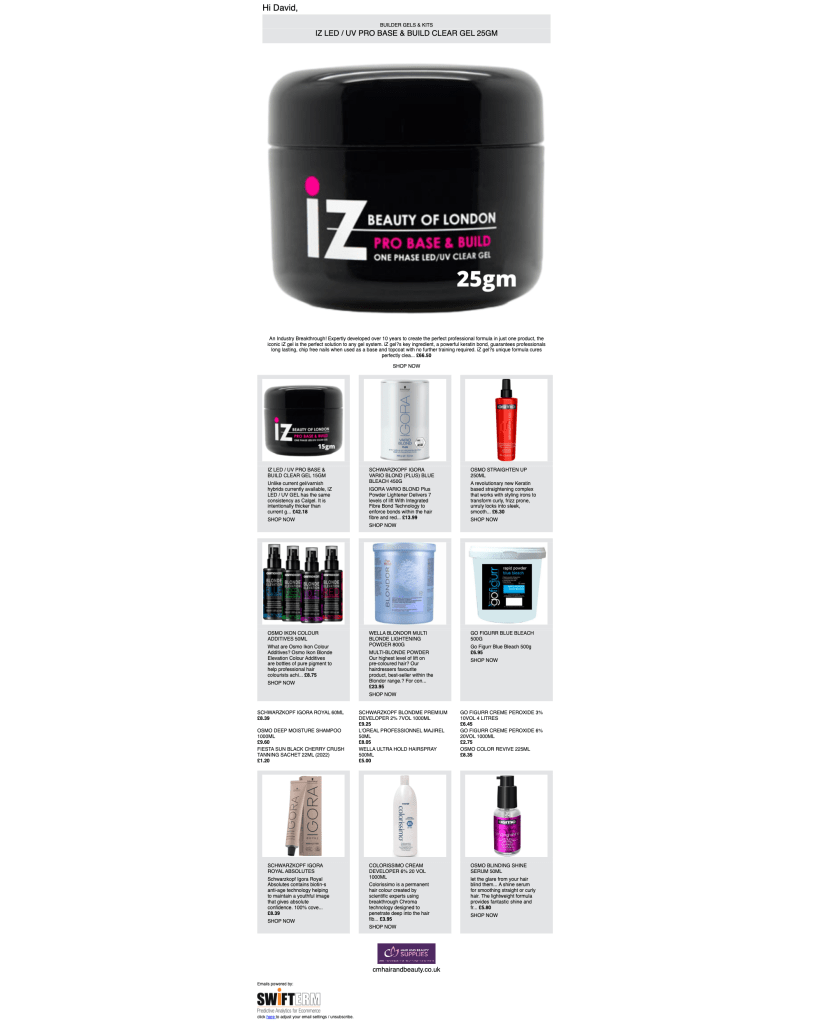The highest ROI in ecommerce marketing is the ideal point to start an assessment of all the tools you have in your war chest, to maximise the greatest return possible for your efforts. If you never stop to look at the performance capabilities of other solutions, how do you know the performance of the ones you do use are the best?
Good tacticians want to avoid the day when a little-known, pissant company, overtakes you in both market share and or profitability. There have been plenty of egos burst along the way, reflecting that someone didn’t do enough to counter potential threats well enough, by checking alternatives. No one wants a competitor to blindside them without prior knowledge.
According to the world’s leading research companies McKinsey, Forrester, Bain and Statista readily proclaim AI hyper-personalisation software for ecommerce now outperforms all other solutions 20-fold, specifically omnichannel marketing and email marketing combined.
So what is hyper-personalisation?
Hyper-personalisation communicates directly and uniquely with each consumer, utilising all the data your site has captured about them, to refine product selections, so they are the ones relevant at that precise time, with an amazingly high degree of accuracy. An artificial intelligence algorithm uses all the captured data on your site (first-party data – with their permission), not only on what people have bought but their navigation and actions and impressions on the site too, which identifies patterns that lead to those purchases.
These solutions are (or should now be) AI machine learning technology, so as time progresses, it perpetuates this refinement on an individual consumer basis, as it accumulates more and more information on each customer. The more knowledge it has about each individual the more accurate the product selection. This in turn delivers the effects intended namely a higher average order value, which naturally means greater customer lifetime value.
But if you’re offering people what they want, rather than products they might buy – perhaps merely satiating a need to shop, then the rate of return drops through the floor too. Savvy CMOs enjoy the multiple benefits of making more profit and saving on costs.
The cherry on the top, of course, is that hyper-personalisation software is wholly autonomous. While you’re running every other aspect of your marketing with their inherent costs, requires zero staff – whatsoever, meaning the GP is all yours.

Hyper-personalisation software drives digital growth via Acquisition to Activation, Retention, and Revenue (AARR)
Let’s take a look at where hyper-personalisation can fit into each stage of the customer lifecycle, and how some retailers are driving digital growth.
Acquisition
Customer Acquisition Costs (CAC) can be exorbitant. It’s very easy to waste valuable advertising budgets by targeting people who will never convert. You can avoid this so-called ‘leaky bucket’ phenomenon by targeting only those users who have a high likelihood of converting.
How? By using hyper-personalisation software utilising AI and Machine Learning technology. It is powered by AI technology and uses individual consumer data to drive their predicted future behaviour (i.e. Likelihood to Purchase, Discount Affinity, Likelihood to Churn).
It autonomously targets customers at exactly the right time, with the right products, to optimise the efficiency of your marketing budget. It automatically sends personalised product content to each person as appropriate and perpetually refines that offering to advance future selections, data-cleansing as it learns what is most relevant to each customer.
Activation
As the algorithms learn more and more about each person, by delivering product selections of infinitely high accuracy to the needs, wants and desires of that person it surpasses the offerings by your peers. This doesn’t go unnoticed, and you move into the enviable position of their go-to source. You delight them with meaningful, seamless experiences at every interaction.
You might assume to do this effectively, you need to understand what they want, and how they behave already. In practice it can be installed simply and easily as a plugin, avoiding the cost to write and implement an in-house alternative, instead adopting technology that people serving this specific technology have already created.
Being an autonomous solution means it requires no human involvement whatsoever. The cost savings go directly to your bottom line, delivering unprecedented savings of staff, and their inherent foibles. See – How much do your staff really cost?
Retention
Increasing your users’ lifetime customer value (LCV/LTCV) is a surefire way to boost your bottom line. Delivering highly tailored, delightful experiences to your visitors helps to build long-lasting relationships that will continue to provide value, both to the user and your business.
hyper-personalisation learns what your customers want, enabling you to deliver meaningful experiences that will keep them coming back for more. After all, retaining those users that you’ve acquired and activated is the key to achieving growth. With personalisation, you can:
- Learn about user preferences to further optimise your customer experience.
- Enrich your visitor profiles with greater clarity, understanding their needs.
- Target customers with hyper-personalised messaging that matches their likelihood to convert.
- Offer hyper-personalised selections which make them feel valued.
Revenue
Hyper-personalisation helps increase the value of each customer interaction. By presenting customers with products, offers, and content that you know matches their interests, you smooth the path to conversion.
By far the greatest returns are due to relevancy and timing. You are not only offering product selections they want, but AI hyper-personalisation for email enables send-time optimisation, so you are effectively putting the right product in front of the right person at the right time.
The highest ROI in ecommerce marketing

These are the month-to-view stats for a Hair and Beauty website. The total customer database is 5551, and hyper-personalised emails sent – 10666. The black line is email sending dates. The orange line is the verified attributed sales, and the yellow line is CTR – 4.85%.
The cost for use of the application to a database of under 20k is £100.
ROI calculations, based on a 60% GP (Hair, Beauty and Cosmetics) = £3022.24, deliver an ROI of 2922%.
This scales proportionately to whatever the size of the company, providing it is serving sites with products consumers interact with frequently – Grocery, Wines, Fashion, Cycles, Chandlery, Saddlery, Fragrances, Books, Music and of course Beauty and Cosmetics, indeed anything where receiving an email a couple of times each month would be appropriate, and therefore yield the desired result.
It doesn’t compete with ERP software either, and this loyalty-building solution selects products unique to each individual without the annoyance of promotional offers or incentives. Precisely because there is no hint of persuasion, outside of the product offering, the rate of suppressions is a trifle in comparison. One ESP partner was amazed that the hyper-personalisation “unsubscribe” rate was 0.003% pa compared to their 18 % pa.
See article: The distinctions between the top 30 hyper-personalisation vendors
SwiftERM is a Microsoft Partner company





